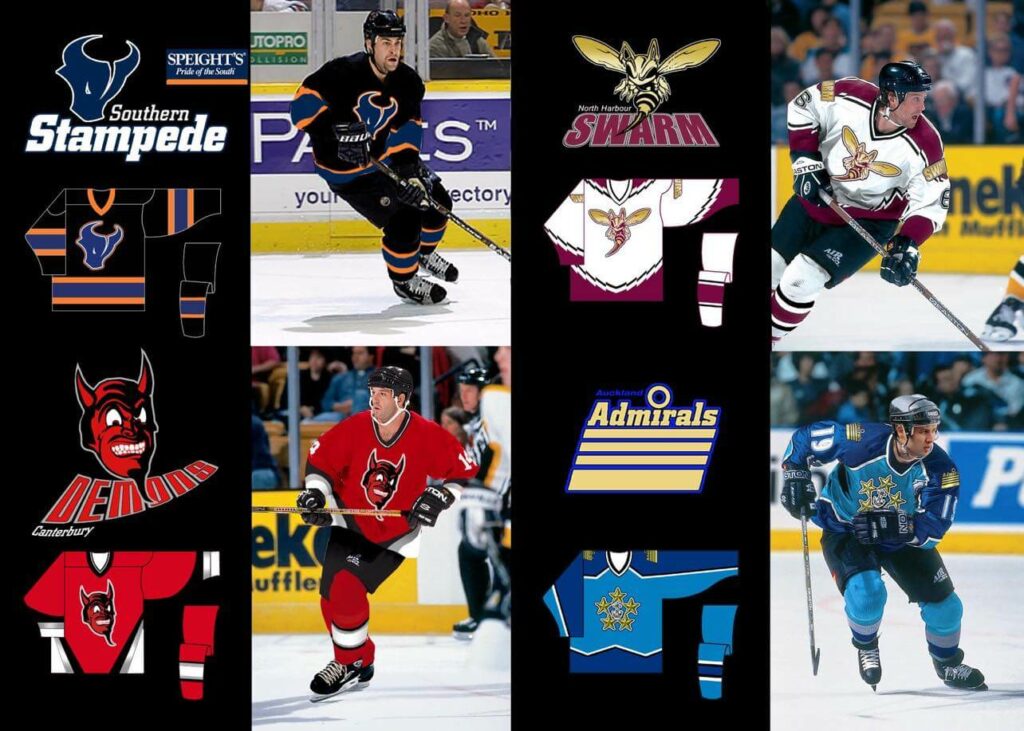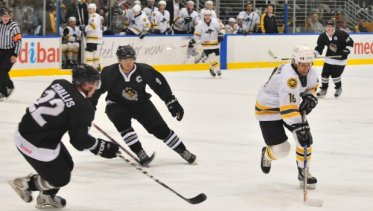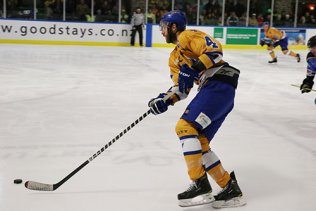
ESTABLISHED 2005: THE HISTORY OF THE NZIHL
2005 was a year of many things like the founding of Youtube and the marriage of Prince Charles and Camilla. More importantly, 2005 marked the year of the very first season of the New Zealand Ice Hockey League (NZIHL). It’s hard to believe that in just 16 years the league has seen a tremendous amount of change including the introduction of u22 players, female players, and a larger engagement in the sport as a whole, The NZIHL has been a catalyst for various development programmes such as the Mako Team, more overseas competitions, and uniting the islands as a whole despite the chirps and ‘your mama’ jokes on the ice.
Prior to the NZIHL, there wasn’t really a national league for senior players. Dennis Monk, former Ice Black, gourmet hamburger creator and ‘goal scoring machine’, describes hockey in the beginning as “more of just a weekend social sport with a few teams that would play each other over the hockey season. At the end of the season, there would be a team selected to compete in the National Champs where one Auckland team would host or travel to either Christchurch or Queenstown to play those teams. So overall, a very social and very amateur level hockey.”
Darren Blong, former Ice Black and National Coaching Director, remembers the main challenges of playing for a National Team without a proper league. “You didn’t play enough games. We may have played five IIHF games and somewhere between 4 to 6 exhibition games before the IIHF tournaments.” How hockey worked before the introduction of the NZIHL was that you would play maybe 20 to 26 games of club hockey, and then played regionals which basically was a once a year tournament between three regions (Southern, Auckland and Canterbury) where a double round robin was played and the occasional North vs South game. Darren also remembers, “We also played against a touring Canadian men’s team usually every year somewhere between additional 3 to 4 games and that was your season.” It was evident that in order to properly prepare our Ice Blacks and develop players as a whole, a National Competition was needed to grow the game and skill. So they went ahead and created one. The Super League was created but never kicked off due to expenses and the poor structure. The season was cut short and New Zealand was yet again left without a National Senior League. But, due to the Kiwi ingenuity coursing through our veins, we picked ourselves back up and started again.

The very first meeting regarding the formation of the NZIHL took place in September at the 2004 Nationals in Gore, which is considered to be the official home of country music in New Zealand. Guenther Birgel, former NZIHL General Manager and the “front footer” of the NZIHL, remembers that many regional representatives were present to discuss the idea of a National League. “Prior to this meeting, some people had already done some work looking at the feasibility of this.” Discussions in the meeting suggested that the idea was too costly and nobody was prepared to run with it. At the time, Guenther was as an Auckland representative on the NZIHF management committee who came on board with the drive to look at the potential of a league and to see if it was sustainable. The largest hurdle for the NZIHL was mostly the cost of travel as the teams would each host games. To compensate this, a format was constructed to play 3 games in every teams’ location i.e. one round each in Avondale, Botany, Christchurch and Queenstown (Dunedin didn’t have a team yet). One team had a bye and the other 3 teams played each other on a Fri/Sat & Sun minimising the travel cost. In total there were 4 rounds which included 6 games minimum for every team and a “finals” round (best of 3 games) at the top of the table team after round robin. This modus was largely used for a few years with some minor modifications until 2008, when the Dunedin Thunder joined the League. Although this did help, they couldn’t afford to fly around disciplinary personnel. Hence, local ‘experts’ got involved in the process. All these people tried their best but of course were mostly looked upon by the visiting teams and fans as being biased.
It took a while for the league to get up and running, with Grant Hay, former AIHA and NZIHF President acknowledging that people were not paid so they can’t work to death. Many hours were put into the league by all volunteers, with Guenther being the lieutenant of the operation. During the season, Guenther was putting in 20 – 30 hours per week into the management and planning. Guenther states, “ It was always a challenge to get an initial schedule to the teams. Rink availability, events, holiday periods, particular team requirements… had to be taken into account… then all the other providers (flights, accommodation, rental vans) could be approached for quotes and be booked. The planning usually for me started after the NZIHL AGM (usually coinciding with NZIHF AGM in Sep/Oct) with the aim to have the majority of bookings in place prior to Christmas. After all pricing was obtained a budget could be established to be sent to the teams for approval. Alongside this, continuous work had to be done on rules, regulations, disciplinary issues, admin, accounting issues, and more for the League.” Guenther wishes to acknowledge Paul de Vere’s professional support with accounting and secretarial tasks which was invaluable.
A lot had to go into forming the league including the naming of the teams. Luckily Darren knew Cam Jones, who played hockey and already had a background in designing Mission team posters for Ice and Inline. Cam recalls how he and Darren went about naming the teams and creating the logos. “With the names we just tried to come up with a something suitable for a team from that part of the country that sounded cool and original as we didn’t want to copy any well known or pro teams names, which was a bit difficult.” Originally, Darren wanted to call Canterbury’s team ‘The Wizards’ after the famous Wizard street performer that would entertain tourists in Christchurch. Due to legal rights regarding the name, the dream was shortlived. The Devils were also going to be the Demons instead, but that name too was dropped. “We kept the logo that we created of a Wizard but removed the hat and added devil horns. The Stampede name was perfect for the farming areas of the South Island. The Botany Swarm was the only one that had no meaning for the region. Was one we just came up with and it sounded great for an ice hockey team. With Auckland we chose The Admirals because it had to be something around sailing. So that was an original name too. I really liked all the team names.”
As the Thunder and Mako teams were not up and running, at that time only the 4 teams were designed. Cam found the logos were relatively easy to create once you have the team name. “I usually only have to do a couple of variations to get a design I’m happy with. The only one we copied from somewhere else was the Swarm Logo. That was a logo design copied from Killer Bees, an old surfboard wax brand. The other 3 were original designs.”
They had the names and they had the logos, but uniform colours were missing. Originally, the Stampede were going to be black, gold and blue due to the potential of being sponsored by Speights. Now some may wonder as to why Botany’s colours are maroon, gold and white when those colours don’t really resonate with East Auckland. Cam has the answer. “Originally the plan was the Botany rink would instead be built on the North Shore of Auckland, which is why the Swarm’s colours are North Harbour rugby colours.”

Logos? Check. Names? Check. Structure? Check. The only thing that was missing was of course the best (or worst) part of the game. Crowds. Guenther remembers that there was a lot of enthusiasm but it was hard to get “bums on seats.” Luckily, with help of social media this has improved considerably over the last few years. Funding was also provided by public trusts and foundations through the years, which has helped immensely. But Guenther stated, “We never knew how much and when any funding may be achieved, so financial planning always assumed no income and hence, the cheapest options in respect of travel, accommodation… was used.” Each team got behind the League in their own ways, some more successful than others. For example, the Admirals had Lloyd Durbin wearing an Admirals uniform and drums were used to support the team. The Swarm have their own unique initiation process. The Devils were well known for their mongrel song “Who let the dogs out.” The Stampede always have had a large following being a relative small place and having winter sports in their veins.
The Birgel Cup is a big name in our Hockey League in present day, with it being the token of being the winner of the NZIHL. Through this article you may have seen a correlation between Guenther’s last name and the name of the cup- Birgel. Guenther recalls how there initially was the “NZIHL Cup” for the finals winner (the old NZIHL cup is housed in the Queenstown club trophy cabinet at the ice rink). However, after a few years the cup was looking worse for wear and it was replaced with a new and better quality model. The cup was paid for with the New Zealand Ice Hockey Federation’s budget, and the naming process then heads underway when five coordinators nominate five cup names. In 2010 the Birgel Cup was named after Guenther’s key volunteer work towards the NZIHL and New Zealand Ice Hockey as a whole.
The creation of the NZIHL was the initial step for New Zealand to take the sport to the next level. Dennis sees the league as, “giving youth hockey players something to strive for which in turn would retain the overall growth of the sport in the country.” Guenther believes that the league increased the level of hockey dramatically. “Looking at the Ice Blacks, they have been a permanent fixture in IIHF World Champion level above (Div II B) they used to play in (Div III). In fact, they keep knocking on the door of level Div II A.” The League has also given officials the opportunity to improve their job and better prepare them for possible IIHF assignments. Grant believes the league was a stepping stone to bring administrators and representatives from around the country together to work with each other to provide better opportunities for our players.
Darren describes the creation of the NZIHL as “the dawn of a new era. One of the real positives that National League has achieved is that firstly not many leagues can say that they actually have added additional teams, and we have fundamentally achieved what we set out to do which was to increase the level of games for a large group of New Zealanders”
Looking at how much the league has grown over the years since that first meeting in Gore, it’s safe to say that those involved have much to be proud of. Cam Jones says, “It’s really great to see how popular the League is. The teams all look great and are still using the original logos except for the Red Devils.” Grant Hay finds the experience, “rewarding, gratifying and good that we could do what we did do while Guenther and I never played hockey. All we could do was find good people like Jeff Bonazo, the Blong’s and those sorts of people who could help. we recognised we knew nothing but we made up for that by motivating people to join.” Grant also had three of his children come through the League, which he found rewarding to have helped them reach their goals. Dennis Monk says, “I look at the league now and am very impressed with the growth, the level of skill and the quality of the game that we can now really promote to spectators.” Guenther Birgel sees that the addition of the Dunedin team added a lot to the League. “It would be fantastic to have a team included from the Wellington region maybe one day (this would have also helped us with league sponsorship, most national companies wanted a Wellington team represented to make any sponsorship viable for them).
In 2011 we started to livestream games with the help of Jez Brown. Although it was trail blazing, the first season of this was tough going with the technology in the rinks not up to the requirements. However, every year this improved and now it has become a standard feature of the League contributing to potential sponsorship and also the exposure attracting more people into the rinks.” Darren Blong concludes with the following: “The formation of the NZIHL is a window of opportunity to make ice hockey legitimate in New Zealand”.
Written By Janna Blong




